When I first saw the Jimmy Skiff II (above) that I reviewed for this issue, I was pleased to see its interior equipped with an offset daggerboard trunk. In “Getting Out of Line,” I had mentioned my fondness for off-center trunks, and Bud McIntosh expressed a similar sentiment in How to Build a Wooden Boat: “The centerboard and its trunk take up room in the best part of the boat, and create an antisocial barrier in an otherwise friendly cabin.” I think he’d also agree that thwarts, as their very name suggests, create a barrier to an otherwise friendly cockpit. The Jimmy II’s removable slip thwarts, and the side benches that support them, are features I’ve found very well suited to rowing, sailing, and sleeping aboard.
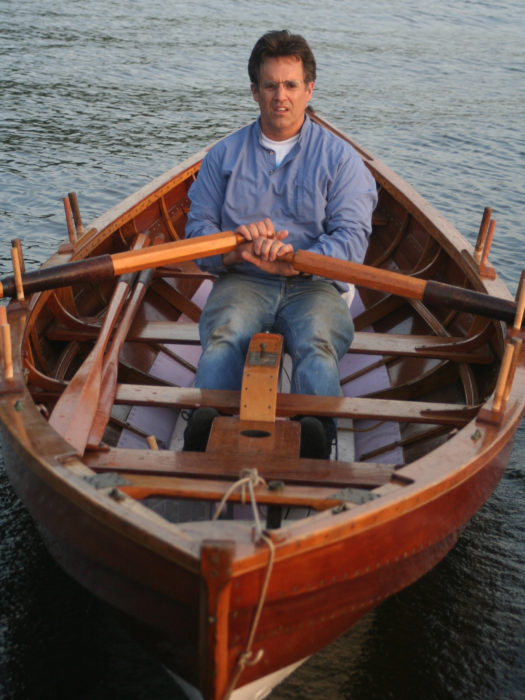 Laurie Cunningham
Laurie CunninghamThe gunning dory is a lovely boat to row and sail as long as I sit down and stay put. Making any sudden moves is perilous. Six-yard hurdles anyone?
My path to considering slip thwarts and side benches began with the Chamberlain gunning dory I built in 1980. In its 19′ length it has five thwarts, and three of them intersect the centerboard trunk and the mizzen partners, so getting from one end to the other at any speed rocks the boat and begs for barked shins.
I’ve spent just one night at anchor aboard that boat—long, uncomfortable, and sleepless hours waiting for daylight—plenty of time to let it sink in that the boat wasn’t at all suitable for cruising. While that boat pointed out the problems of a cluttered and unalterable interior, the 13′6″ sneakbox I built in 1985 provided some solutions. The seat for rowing was not a fixed thwart but a box that could be tucked under the deck at night to open up the cockpit for sleeping. Its daggerboard trunk was set 12″ to starboard and part of the coaming, leaving the center of the boat free.
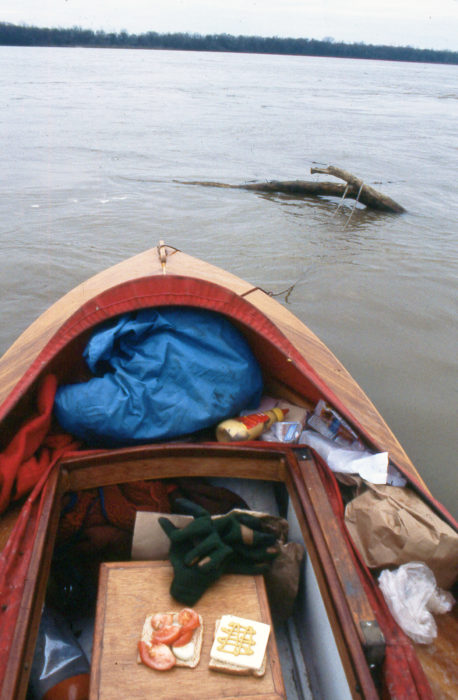
With the pad removed, the box that was my rowing seat served as a lunch kitchen. The daggerboard trunk, out of the way to the right of the sandwich makings, has a cap over its opening to block the splash. During this break on the Ohio River, the wind was blowing upstream, so I took a tow from tree trunk that was drifting down river.
In 2005, when I built a Caledonia yawl for camp-cruising with my two kids, I kept the hull and sailing rig as designed but started from scratch for the interior arrangements. Applying the sneakbox’s lessons of asymmetry and adaptability, I moved the centerboard trunk 14″ to starboard. (Keeping its top at seat level and raising it bottom up the slope of the garboard diminished the depth of the trunk, so I made it longer to give the board the same area.)
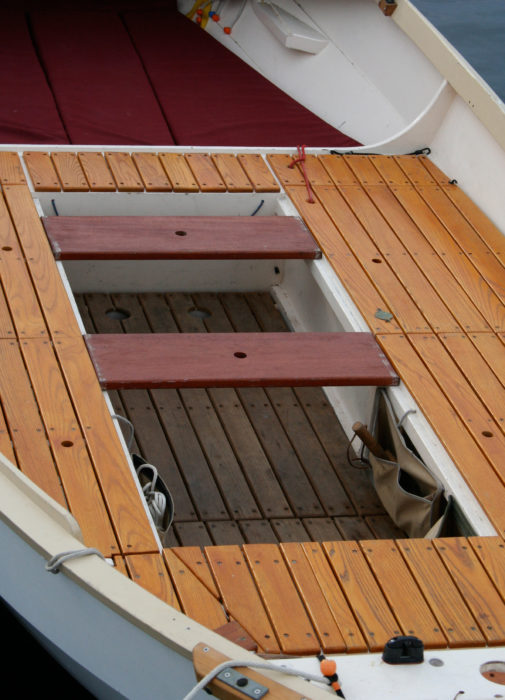
The slip thwarts can be positioned anywhere on the ledges. A dowel inserted into the holes in the thwarts connects to two and holds them upright to support a table.
The trunk led to wide side benches with parallel inboard edges, and those invited a modular system where slip thwarts and floorboards could rest anywhere on ledges to fill the gap between the benches.
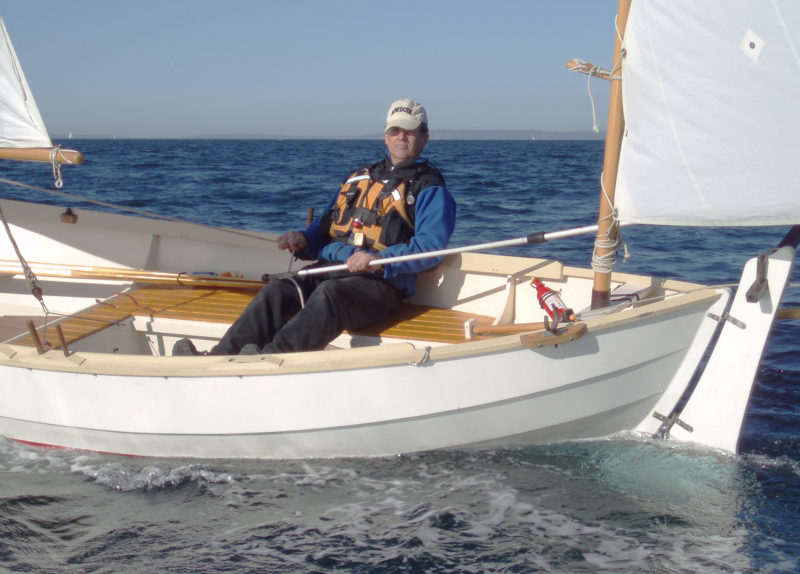 Todd Waffner
Todd WaffnerWhen my Caledonia yawl is heeling, the inboard edge of its leeward bench is in the Goldilocks zone for bracing my feet: a centerboard trunk would be too close and a traditional side bench too far.
The resulting width of the side benches brought some benefits I hadn’t anticipated. Standard benches are usually fairly narrow, and their curves parallel the contour of the hull. A 9”-wide side bench, like that in my 14’ Whitehall, is not much of a seat while at anchor, let alone when a boat is under sail. When the boat heels, the weather inwale angles into the small of your back and pries you off the bench. With a wide side bench you can lean against the inwale and still be well planted on the seat. In light air, the wide bench also allows you to shift your weight inboard in response to lulls in the wind. The inboard edge of a leeward wide bench, which is closer to the centerline than that of a narrow bench, can make a foot brace that’s better positioned to keep your weight on the high side.
Side benches also provide voluminous, out-of-the-way storage areas. The Jimmy II has watertight flotation or storage compartments; those in my Caledonia just have slatted tops and canvas-panel fronts, but they protect the dry bags and keep the hull’s sloped sides from funneling them into the middle of the boat, right where I need to put my feet.
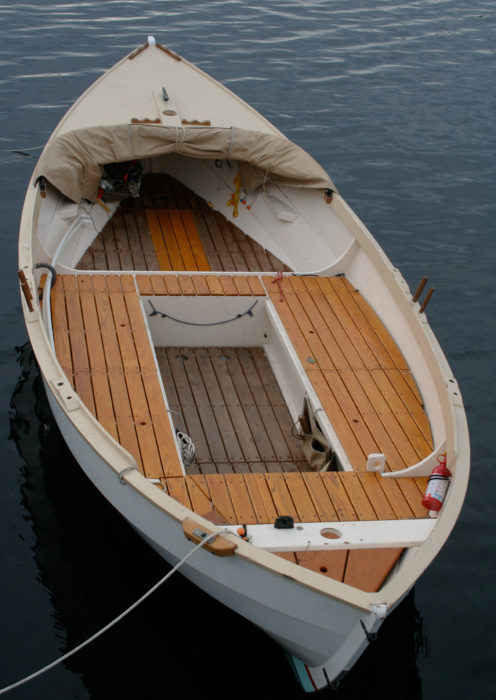
The side benches provide a cockpit and a footwell that’s the equal of a much larger sailboat. The central transverse bench is the only obstacle between the bow and stern areas. The off-centerboard trunk supports the forward end of the starboard bench.

With the floorboards set on the ledges, the cockpit becomes a queen-sized sleeping area.
My yawl has a bit of deadrise, so it needs floorboards to provide a flat surface to stand on. I made the floorboards as wide as the slip thwarts are long so they can also be set on the bench ledges to create a large sleeping platform. Some argue for sleeping in the bottom of the boat to get the best stability, but I’ve never had any issues with sleeping at bench or thwart level in any of my boats.
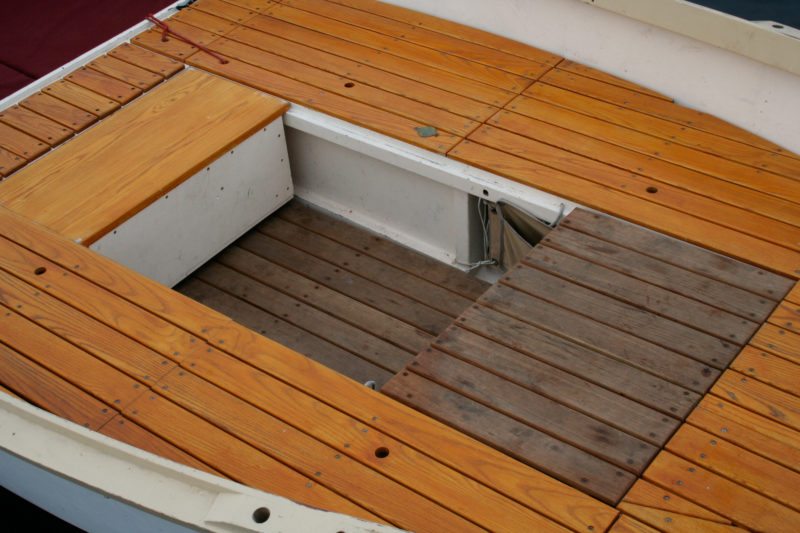
The galley box, flipped upside down, rests its oak-plank base on the ledges. It takes the place of a slip thwart for rowing. Here the aft floorboards are also resting on the ledges to add to the seating area.

Flipped, the galley box holds two stoves, ready to cook. When everything is stacked for storage, the contents of the box don’t shift much and stay in place when the box is upside down. The box cover has been put aside; the black straps hold in place. The slip thwart gives the cook a place to sit, surrounded with lots of side-bench kitchen-counter space.
Other extensions of this “modular” approach made possible by galley-box benches supported by the ledges—right side up to cook, upside down and closed to be used as a thwart while under way—and a dining table created by setting a floorboard on a pair of slip thwarts set on edge.
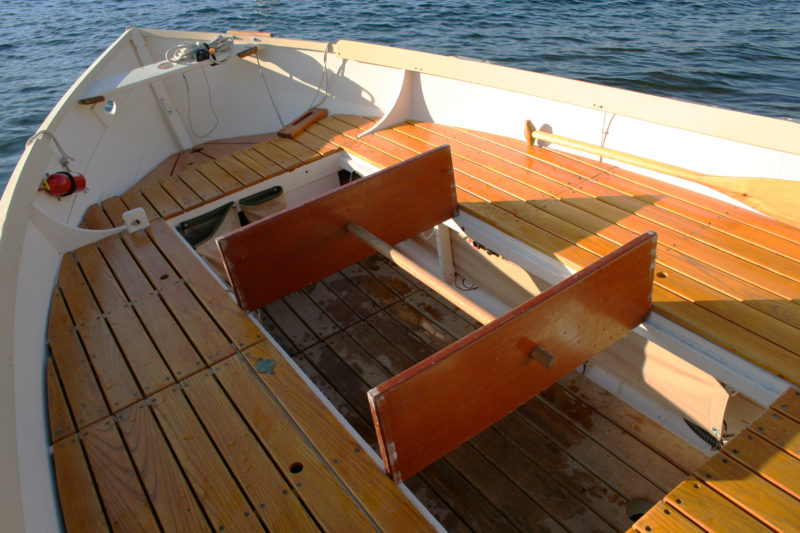
With the slip thwarts set on edge on ledges and held upright by a length of dowel, they’re ready to support the floorboards as a table top.

For those who are put off by eating off floorboards, I carry a table cloth. There’s no pulling chairs back to get seated, but once at the table, the diners are all comfortable.
When I decided to build a boat with accommodations for cruising in the off season (see “A San Juan Islands Solo“), I incorporated the the side-bench/slip-thwart concept in the cockpit and the cabin.

I made a narrow floorboard that serves as the rowing seat, making a dedicated slip thwart unnecessary.
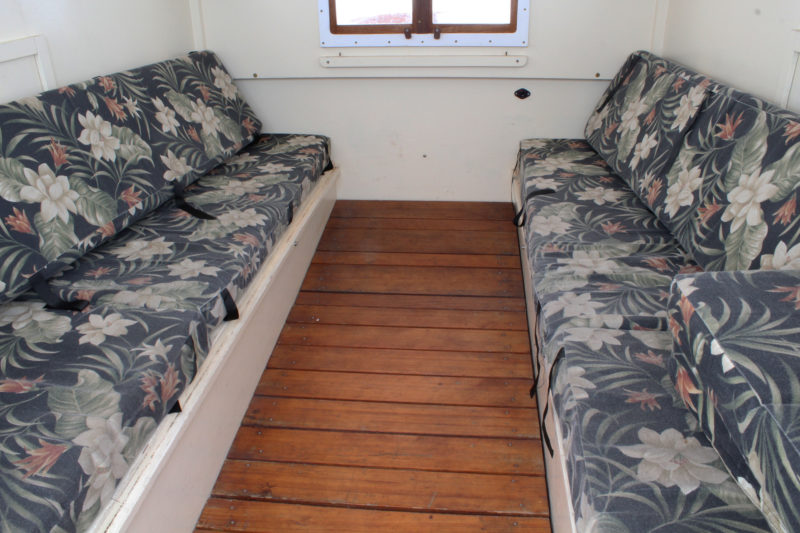
I extended the benches and ledges of the cockpit into the cabin of my little cruiser, HESPERIA. The floorboards spend much of their time on the cabin floor, though I have small rugs underneath them for comfort when the floorboards are used as a catwalk on the cabin roof.
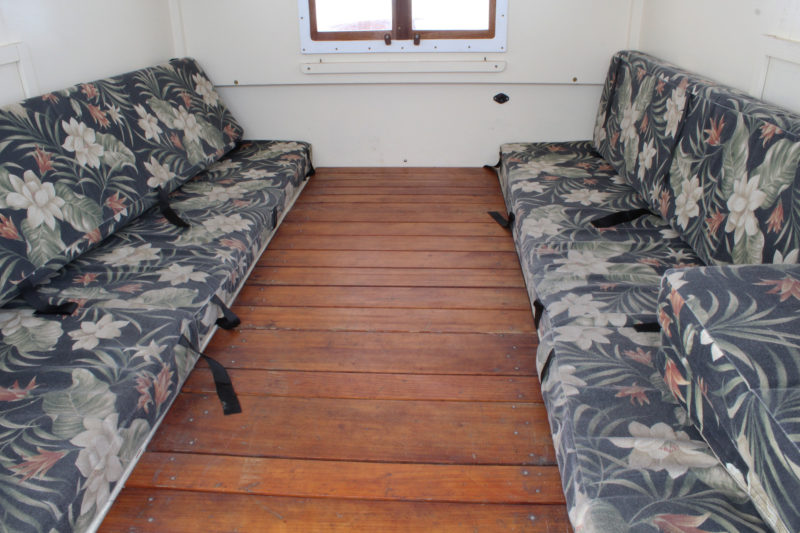
Come bedtime, the floorboards rest on the bench ledges to make a broad sleeping platform.
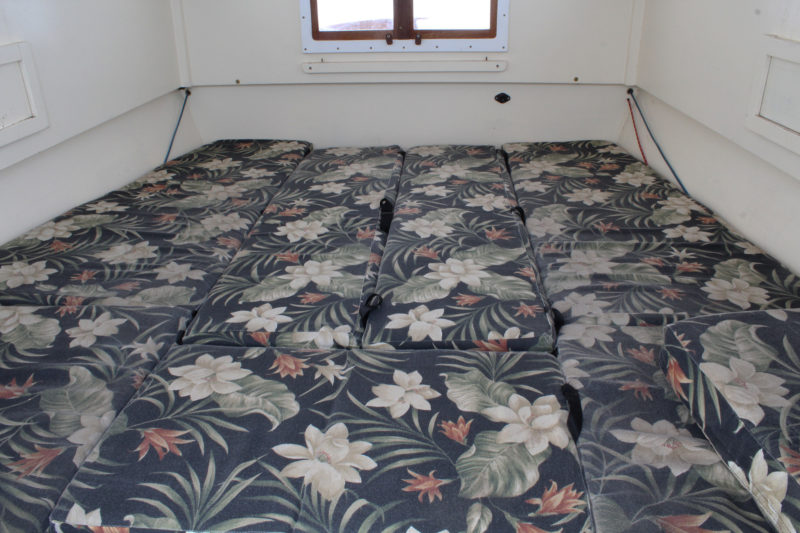
The backrest cushions cover the floorboards, making a queen-sized bed.
In 1927, the architect Le Corbusier wrote: “Une maison est une machine-à-habiter”—A house is a machine for living in. We inhabit our cruising boats, and they too should be machines designed for our living aboard them. A good measure of their performance is the ease with which we can use them. Your boat should adapt to you, not the other way around.![]()

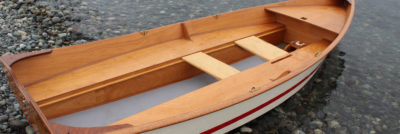

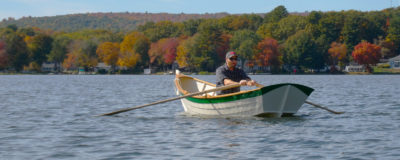
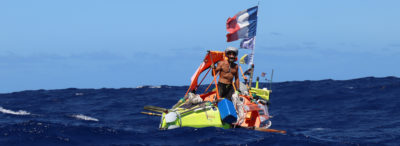
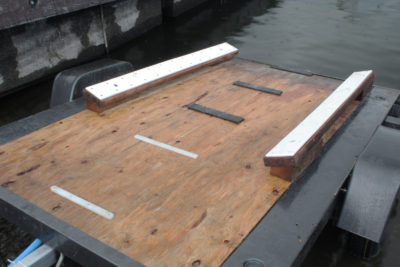
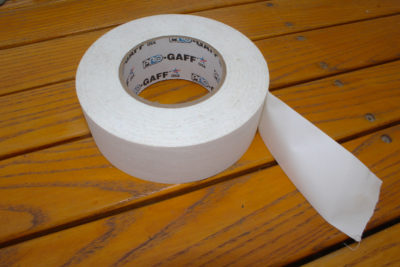
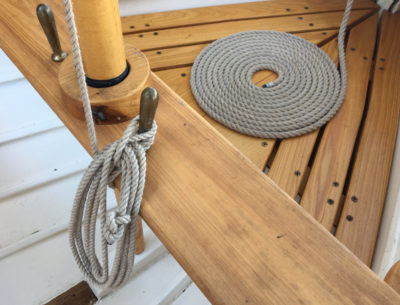
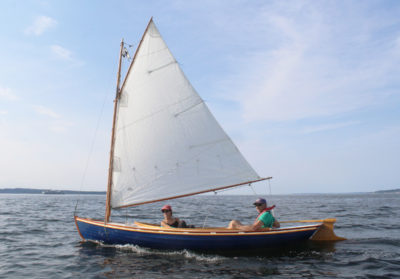
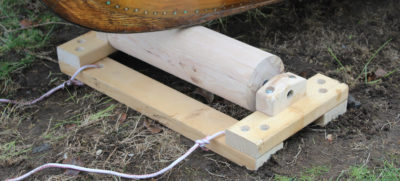
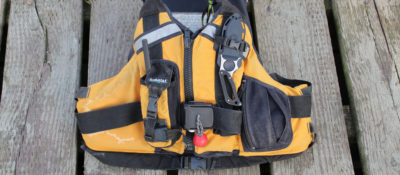
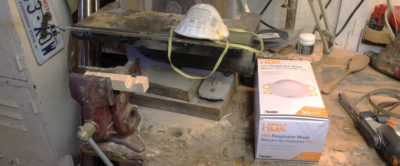

Christopher, are there pictures anywhere of your little cruiser?
Yes, there are lots of photos and videos in an article I did about a cruise in the boat, HESPERIA, to the San Juan Islands: A San Juan Islands Solo.
As always, well detailed and inspiring! thanks for sharing all of this. Is there more detail on which boat of yours is accommodated thus for off-season cruising?
Yes, please see my cruising article “A San Juan Island Solo.”
Some truly great ideas.
Very innovative, Chris. Any idea how much upwind performance suffers with the offset centerboard?
With both my sneakbox and my Caledonia yawl, there is no perceptible difference in performance under sail with an offset board. With the yawl, I wanted to see what would happen if I sailed hard to windward and got the boat to heel enough to have the top of the board break the surface of the water. With the Norwegian tiller I was able to do that and peer over the windward rail and see the board emerge from the water. It was slicing cleanly through the water and not drawing any air down at the trailing edge. I couldn’t detect any increase in leeway.
There is a perceptible difference in sailing to weather when the mainsail’s shape is spoiled, whether it’s the lugsail wrapped around the mast or the spritsail around the sprit. If I have a long crossing to make on one tack, I’ll set the sail downwind of the spars to get the best shape and performance. I’ve never wished I could relocate an offset board, either to the other side or to the centerline.
Great-looking boats. I owned a Bolger Dovekie for a while, and had a chance to sail my Dovekie “Harmony” with the boat designer Jim Michalak, who was in a Bolger Birdwatcher that he built. Our sprit sails and sprit booms were set on opposite sides of our masts – one to port of the mast, and the other to starboard. Sailing side by side, we tried to figure out whether our boats were slowed on the tack where the sail was pressed against the sprit boom, as opposed to being free. We couldn’t tell for sure, but it made for an interesting afternoon of sailing. The Birdwatcher is designed for the pilot to stand fully upright, and I can picture Jim standing in his birdwatcher as we sailed – we had a long, slow gam about the issue. (Confession: OK, I’ve owned two different Dovekies, and I had a lovely Bolger Shearwater in between the Dovekies. It’s a long story.)
Although not the main focus of the article, I love the way you have created a lounge, a bedroom, a kitchen, and a dining room out of the cockpit area. It’s a masterclass in thoughtful design and careful planning and measurement of components. Well done.
Out of interest, where is the galley box stored when not forming your kitchen or rowing seat?
Thanks, Chris. Cruising taught me that whether or not I sail or row on any given day, I’ll always need to sleep. So with the Caledonia yawl and my Garvey cruiser, the first thing I did was map out places to sleep. For the yawl, I made a plywood “gingerbread man” to scale and set him on the plans to see where he could sleep. Both boats can comfortably sleep four.
When the galley box is upside down, that’s how it’s stored and why I could make it big enough to hold and cook with two stoves. While it’s serving as a rowing seat, a slip thwart can get tucked out of the way under one of the side benches.
Lots of interesting design elements here to make a cruising boat truly habitable—thanks for sharing, Chris. My own approach is closer to the “adjust your mindset to make comfort less essential”—the lazy sailor’s way of dealing with life afloat (and perhaps more importantly, the lazy SOLO sailor’s way)—but reading this, I’m tempted to move toward the dark side and build in a little more comfort and convenience.
I just got to ask? Seems like you are rigged for sculling on your CY? How does she scull?
Glenn Holland, fellow CY builder
I added an oarlock to the port side for sculling and for using an oar to steer if the rudder gets broken. For sculling I’ve just been using on of the 11′ 4″ oars that I use for rowing. That works OK for short distances—even with the long oar, it’s at a steep angle. I occasionally think about making a longer yuloh for easier sculling.
I love this Chris, all the useful configurations you get from a few multipurpose parts. Very clever.
To riff on your slip thwarts, how about a sliding thwart. This is a wheeled seat rolling on the side seats of a Welsford Walkabout. With this you get sliding seat rowing, but without a drop-in rig that takes up the center space and interferes with the sleeping area.
Some great ideas in here with the CY, thanks for the good photos.
I have to say it because my racer-in-me can’t keep his mouth shut. Side benches sometimes lure people into sitting in positions that wonk out boat trim. I tend to see many small-boat sailors sitting on their side benches attempting to go to windward but dragging their transom with the bow up in the air. It’s good to be mindful of boat trim for best performance, just because there is a place to sit doesn’t mean that’s where one should sit.
I’m with you, Christophe. I don’t race, but having been boating most of my life, I’m quite sensitive to boat trim and feel quite uncomfortable if a boat isn’t level while rowing or heeling appropriately for the sailing conditions. I’ve learned to accept the fact that not everyone I may share a boat with is going to be as attentive and may plant themselves somewhere and be perfectly content to stay put. Even my father, who taught me a lot about sailing, needed my directions to shift his weight. His sensitivity to small-boat sailing trim had been dulled by his many years aboard a 27’ sloop with a full 2,000 lbs of ballast working on his behalf.
The slip thwarts are an essential element of my side-bench layout because they provide the necessary lateral mobility. When I have company aboard my CY, I’ll usually have the passenger sit amidships and then put myself where I need to be for good fore-and-aft trim. I’ll set the length of my adjustable Norwegian tiller and place a slip thwart between the side benches. I can take care of the ongoing fine tuning of the lateral trim and ask my passenger shift only as needed.
Some great ideas here, Chris. And for me quite timely as I am just getting around to designing the bench configuration for my next build. Do you think double enders are a little more tolerant of an unbalance in fore and aft trim (not having a transom to drag along)?
I suppose double enders might be more tolerant of being out of fore-and-aft trim than a boat with a transom that can be immersed enough to cause some drag. My Caledonia yawl, a double ender, might not be bothered by being down at the head or the stern a bit, but I mind. I haven’t done any trials with a GPS to see what difference there might be as I shift weight to change the trim. I suspect there would be minor losses of speed with minor changes out of trim, but I’d feel compelled—by something bred into me—to do something to achieve proper trim regardless of whatever speed I might gain. If your boat has transom that presents a broad face to the water, immersing it might more quickly add to the drag than a double ender, so the fore-and-aft trim does become more of an issue, and the parallel side benches and adjustable slip thwarts more of an asset.
Chris,
How did you reshape the top of the centerboard and how do you control the board? I’m thinking about moving the centerboard on my Guillemot. I noticed both boat have the same center board control with the extended “ear” on the top of the board, yet your boat has a sealed case and control lines.
Jim
The forward/top end of the board is a half circle with a groove in the edge. The downhaul, anchored in a hole in the edge of the board (under and a bit forward of the pivot bolt when the board), lies in the groove and emerges from a hole in the front of the trunk. The up-haul is secured to the trailing edge of the board and emerges from the trunk aft of the downhaul. In the photo with the caption beginning “The galley box, flipped upside down” note the two red lines by the front starboard corner of the galley box/thwart. A tripping cleat forward holds each line as needed. When it’s holding he board down, the cleat will trip and release if the board hits something. The downhaul has very little mechanical advantage, so I put another hole in the trunk for a pushrod in case the board gets hung up on a bit of grit and needs coaxing. In the same photo, there is a pivoting round brass plate covering the hole and holding a rubber plug in it. A brass bar let into the trailing edge of the board provides a durable surface to push against.
Good design thinking. Inspirational! Have you conceived a way, given deeper benches and floorboard clearances, to somehow store oars more out of the way? Thanks.